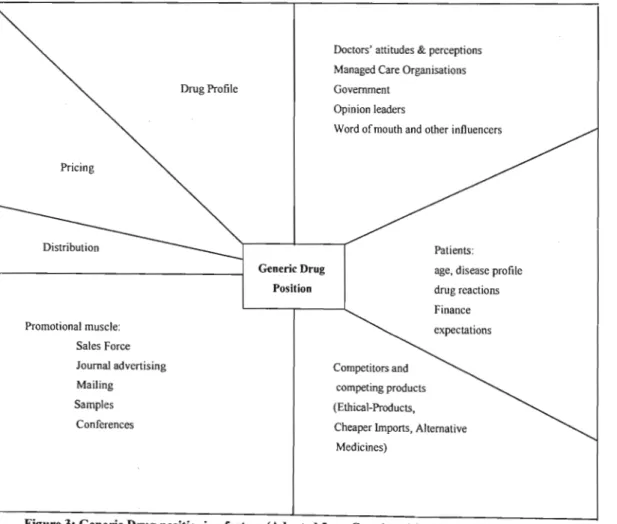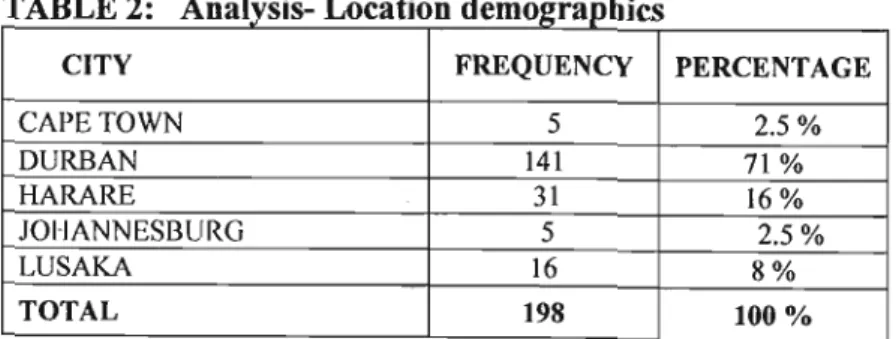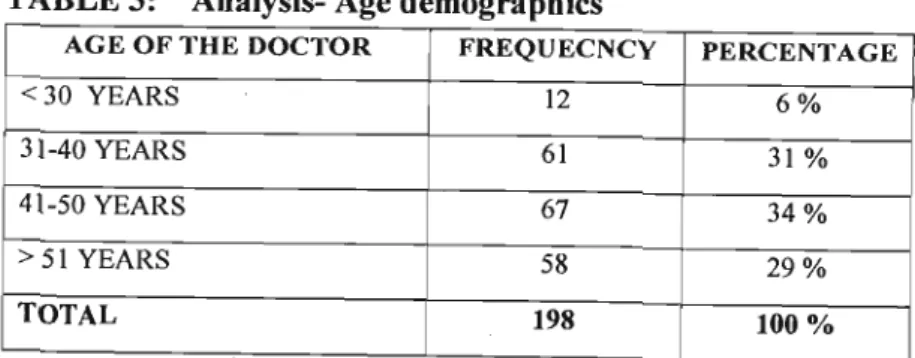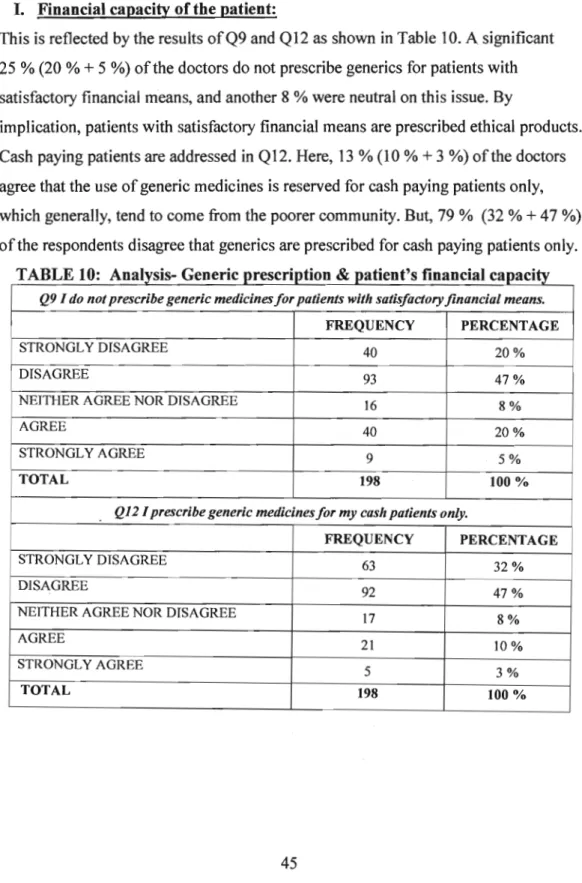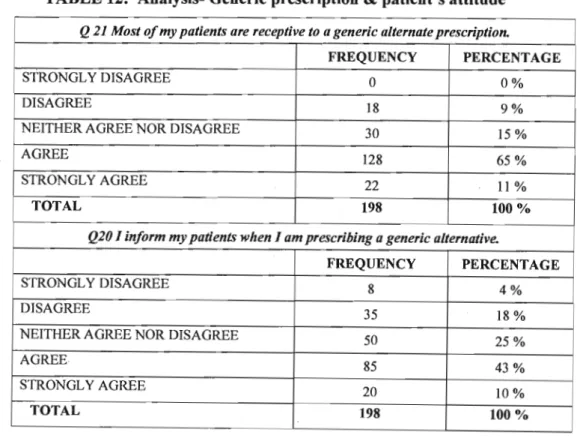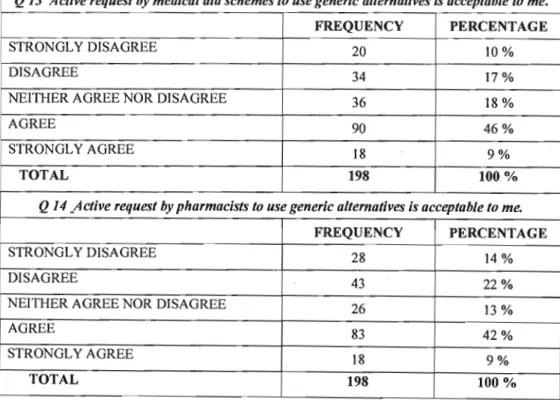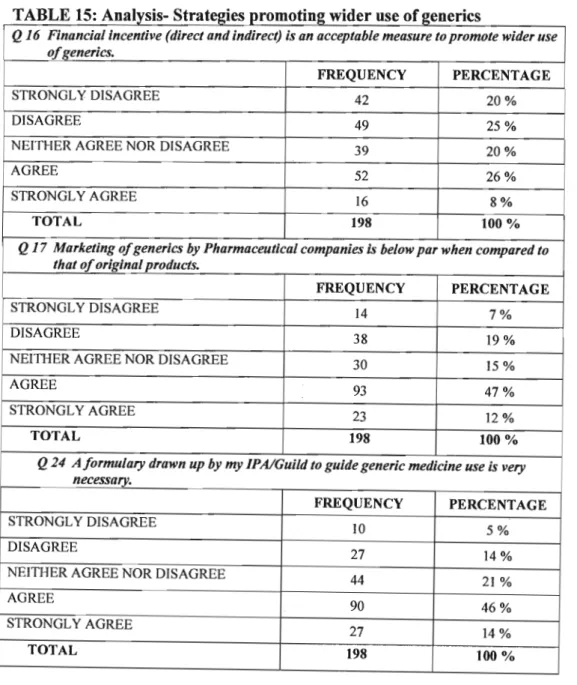Further reductions in generic drug prices are therefore likely to increase use. The wider use of generic drugs by .. specialists will have a positive effect on the prescription of generic drugs by family doctors. In order to achieve reductions in healthcare costs by promoting wider use of generic drugs, the various stakeholders in the industry must work synergistically. stakeholders need to increase awareness of generic drugs through continuing health education.
For grammatical convenience, both family physicians and patients are referred to in the masculine gender. All of these factors affect the family physician in the private sector, who is the "gatekeeper" in providing cost-effective health care to the public. Managed care organizations also play an important role in the prescribing of generic drugs by family physicians.
AIMS OF THE STUDY
Pharmaceutical outcomes management, in the form of managed care organizations, seeks to identify the most effective therapy, delivered in the most efficient manner; with the goal of improving patient care. As analytical tools, pharmacoeconomic and pharmaceutical outcomes studies provide valuable information regarding the costs and consequences of drugs used by physicians. Family practitioners, along with such other members of the health care team, serve an important role as the therapeutic outcome managers by ensuring that the.
Therefore, it is important to find out his attitude and perception and the factors that influence his prescription.
STRUCTURE OF THESIS
REVIEW OF LITERATURE
THE PHARMACEUTICAL INDUSTRY AND GENERIC MEDICINES
- PATENT LAWS AND GENERIC MEDICINES
- THE INDEPENDENT GENERIC PHARMACEUTICAL INDUSTRY ALLIANCE (lGPA)
- FACTORS FAVOURING GENERIC DRUG COMPANIES
- CHALLENGES FACED BY THE GENERIC PHARMACEUTICAL INDUSTRY
- CHALLENGES FACED BY ETIDCAL PHARMACEUTICAL INDUSTRY
- STRATEGIES USED BY THE ETHICAL PHARMACEUTICAL INDUSTRY
- RECENT TRENDS IN THE PHARMACEUTICAL INDUSTRY
Despite their lower price, generic drugs did not gain much market share - only 8% of all prescription drugs in the D.S. in 1997. (Kalbhen J, 1999). After the expiration of patents, generic drugs with multiple sources compete heavily with each other in the price-sensitive market, reducing their profit margin. Company and brand loyalty are crucial factors in the success of any pharmaceutical industry product.
Oligopolies operate in the largest and wealthiest segments of the economy where fees account for the majority of industry output (Matthews J, 1996). However, this trend may not be in the best interest of the consumer (patient) and the family physician. Various stakeholders in the pharmaceutical industry – ethical and generic manufacturers – were briefly analyzed.
THE FAMILY PRACTITIONER
- FAMILY PRACTITIONER AS A GATEKEEPER
- ATTITUDES, BEHAVIOUR AND PRESCRIBING HABITS OF THE FAMILY PRACTITIONER
The attitudes and prescribing habits of the family physician play an important role in drug consumption. In this model, the family physician must first be aware that a specific generic version of the drug is available, and then must demonstrate a positive interest in it before intending to prescribe it. Such repeated use of generic drugs by the family physician should save costs.
34; Side effects sensitive" - These family doctors are often focused on the side effects of drugs and, therefore, are inclined to try newer drugs with a reduced side effect profile. Corstjens M, (1991) , classifies the family physician and his prescribing habits according to physician lifestyle criteria The pharmaceutical industry uses these behavioral, attitudinal, and psychographic approaches to develop a competitive advantage in marketing their products to family physicians.
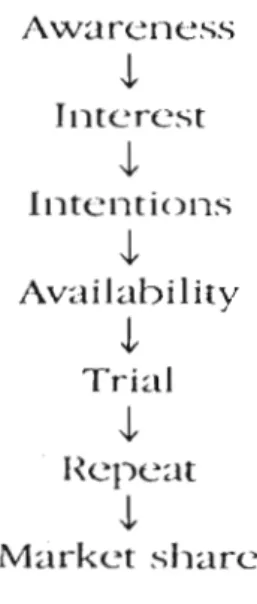
FACTORS AFFECTING THE PRESCRIPTION OF
PHARMACEUTICALS BY THE FAMILY PRACTITIONER
- INTRODUCTION
- MANAGED CARE ORGANISATIONS
- GENERAL
- STRATEGIES USED BY MANAGED CARE ORGANISATION Managed care organisations are thrusting heavily in the direction of
- MANAGED CARE ORGANISATIONS AND THE FAMILY PRACTITIONERS
- MANAGED CARE ORGANISATIONS AND THE PATIENT Patient factors like the patient's age, his disease profile, availability of the
- SPECIALIST PRESCRIBING AND THE FAMILY PRACTITIONER Family practitioners generally respect a specialist's opinion and specialists tend to
- MARKETING OF ETIDCAL DRUGS
- GOVERNMENT AND LEGISLATION IN SOUTH AFRICA A key element for restructuring ofthe South African national health system is to
- SOUTH AFRICAN HEALTH CARE INDUSTRY
- SOUTH AFRICAN PHARMACEUTICAL MARKET
- GENERIC MEDICINES FOR HIV/AIDS DRUGS IN SOUTH AFRICA Brewing since the advent of South African democracy in 1994, and the promises of
- RESEARCH METHODOLOGY
- INTRODUCTION
- RESEARCH DESIGN
- DESCRIPTION OF THE RESEARCH SAMPLE
- VALIDITY AND RELIABILITY
- RESEARCH STUDY INSTRUMENT -THE QUESTIONNAIRE The measuring instrument for the data collection was a questionnaire. The data was
- DATA ANALYSIS
Failure to take such cost considerations into account, explains Lexchin J, (2000), will result in increasingly unaffordable contributions from consumers or result in the insolvency of managed care organizations. Encouraged by the worldwide recognition of the effectiveness of generic drugs, the South African government also advocates greater use of generics (NDP, 1996). By having strict criteria for drug registration, the MCC assures South African family physicians of the safety of drugs available in the country (Moodley I, 1996).
The public sector is financed from the fiscus, and mainly provides for the unemployed and the impoverished sections of the population. One of the goals of managed care is to combat the rise in health care expenditures in the hospital and pharmaceutical sectors (Moodley I, 1996). There is now consensus by most stakeholders in the health care scenario that it is necessary to implement the cost saving measure of the wider use of generic medicines to limit the health care expenses.
It will also assess individual characteristics and personality traits of family physicians in relation to their prescribing of generic drugs. A secondary aim of this study is to assess some of the factors influencing prescribing by family physicians. We explained the aims of the research to the family workers and emphasized its anonymity and confidentiality.
A follow-up telephone call was made to the physicians and the guild's executive committee to thank the physicians for their participation in the study. Detailed questions that categorize some of the personality traits of the family therapists that influence their generic prescription. The answers provided the basis for an in-depth statistical analysis of the answers to the questionnaire.
These characteristics of family practitioners were analyzed using frequency studies and chi-square cross-tabulations using SPSS.
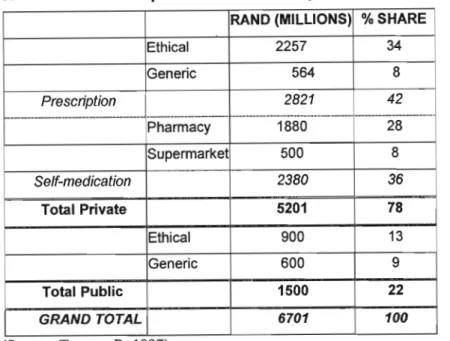
CHAPTER4: RESULTS
- RESEARCH SAMPLE-DEMO GRAPHICS
- ATTITUDES OF FAMILY PRACTITIONERS AND THE FACTORS AFFECTING PRESCRIPTION OF GENERIC MEDICINES --DESCRIPTIVE
- RELIABILITY TEST
- FACTORANALYSIS
- INTRODUCTION TO FACTOR ANALYSIS
- SCREE PLOT
- FIVE FACTORS
- CHARACTERISTICS AND THE PERSONALITY TRAITS OF THE FAMILY PRACTITIONERS AS RELATED TO THE PERCENTAGE OF
Around the family, GPs report that the overall percentage of generic prescriptions is less than 75%, with ethical medicines making up a significant proportion of prescription medicines. In the questionnaire, attitudes and perceptions of the general practitioner in relation to the exorbitant costs of medicine were tested by Q6, Q7 and Q8. Moreover, the respondents also admit that the cost of medicine actually limits their ability to provide satisfactory care to their patients.
Of interest to the doctors agree that they are concerned when they use generic drugs for a patient with a serious illness and will prefer, implicitly, the use of ethical drugs. Here it is clearly shown that only GPs agree that the active request by medical aid schemes to use generic alternatives is acceptable to them. A significant number of GPs agree that they are often disappointed when supporting specialists prescribe the original brand drug over a generic drug, indicating higher use of ethical medicines by supporting specialists.
In addition, some of the doctors feel that their supporting specialists are unhappy when a switch to a generic alternative is made. Regarding the marketing of generic drugs, the doctors feel that the marketing of generic drugs is below par compared to that of ethical drugs. In the correlation matrix, most of the data have the correlation coefficient of the value of 0.3 or higher.
Here, the 45.2% of variance not explained by the five factors represents a limitation of the factor analysis. This is another important factor that explains 12.7% of the variance for the Principle component extraction, Varimax rotation. This important factor reflects the impact of the high cost of drugs, as well as the cost consciousness of family physicians.
This means that in this study no relationship was found between the percentage of generic drugs prescribed and the "type" of doctor.
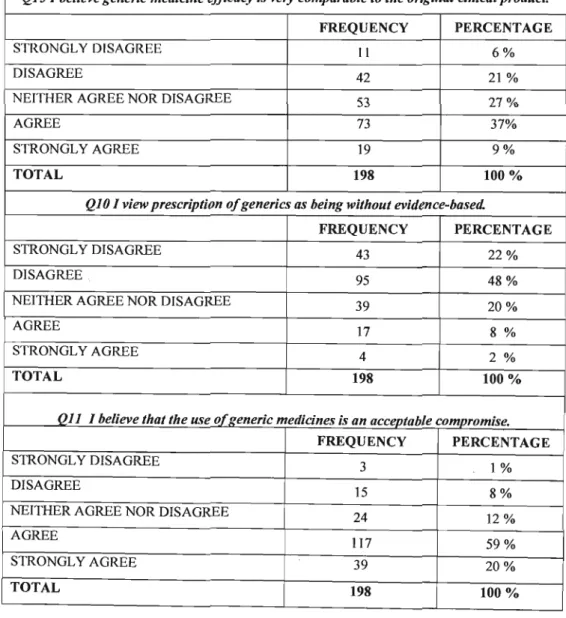
CROSSTABS Chi-Souare Tests
To identify the individual, the chi-square cross-tabulation test was chosen. characteristics of general practitioners who emphasize high use of generic medicines rather than low use. The percentage of generic medicines prescribed by an individual doctor was compared with other characteristics of the general practitioner, such as the age of the doctor, the duration of the general practice and the type of practice. pharmacy versus pharmacy practice, and the percentage of cash-paying patients in the practice). When this was done in this study, no significant relationship was found because the p-value was always greater than 0.05.
CROSSTABS
- PROBLEMS ENCOUNTERED BY GENERIC MEDICINES
- RECOMMENDATIONS BY THE FAMILY PRACTITIONERS TO INCREASE GENERIC USE
- RESEARCH CONCLUSIONS AND RECOMMENDATIONS
- ACIDEVEMENT OF THE RESEARCH OBJECTIVES
- Doctors' clinical autonomy
- CHARACTERISTICS AND PERSONALITY TRAITS OF THE FAMILY PRACTITIONERS AS RELATED TO THEIR GENERIC PRESCRIPTION
- LIMITATIONS OF THE STUDY
- AREAS FOR FURTHER RESEARCH
67 % of the responding physicians expressed serious concerns about the effectiveness/efficacy of the generic drugs. 53% of the family practitioners were concerned about the increased side effect profile experienced with the use of generic drugs. 65% of family practitioners complained that the generic medicines available "are not as cheap as they should be".
Lack of patient trust in generic medicines remains a problem, as mentioned by 35% of family doctors. Irregular supply of generic drugs in the market was cited as another problem faced by 24% of doctors. Price: About 60% of doctors believe that a lower price of generic drugs would help increase their use.
Stricter monitoring of generics: 42% of GPs would like a regulatory body such as the MCC (Medicines Control Council) to monitor more closely the quality of generics on the market. 10% of physicians think that formulary and/or legislation will also enforce wider use of generics. Using factor analysis, this study identifies five important traits that influence the attitudes, perceptions, and prescribing habits of family physicians.
Some practitioners suggest that the generic industry, like the ethical pharmaceutical industry, follow some of these strategies to actively market their generic products. In this survey (TABLE 15, page 50), 59% of physicians believe that marketing by the generic pharmaceutical industry is below par. At present, marketing from the generic pharmaceutical industries is negligible and often the general practitioners are often unaware of the availability of generic drugs.
Decrease in the price of the generic drugs should increase its use and its market share.
Academia-Pharmaceutical Industry Relations: The Legislative Background and Its Effects on Medical Research and Development Expenditures Clin Invest Med 1996; Vol19, Issue 6, pp.470-8. The Public-Private Interface - Models for Providing Cost-Effective Health Care to Unaided Patients - Conference on Pharmaceutical Benefits Management, Institute for International Research, 29-30 October 1996, Holiday Inn, Johannesburg International Airport. National Drug Policy for South Africa, Department of Health, 1996 http://wwwhst.org.za/pubs/ndp/a.htm Accessed December 2000.
Effect of multiple-source entry on price competition after patent expiration in the pharmaceutical industry Health Serv Res 2000; Vol. 35, Issue 2, pp. 529-47.
ANNEXURE:1 THE RESEARCH QUESTIONNAIRE
- ARE YOU A DISPENSING DOCTOR?
- HOW LONG HAVE YOU BEEN IN FAMILY PRACTICE?
- WHAT PROPORTION OF YOUR PRACTICE ARE CASH PAYING PATIENTS?
- WHAT PERCENTAGE OF YOUR TOTAL PRESCRIPTIONS ARE GENERIC MEDICINES?
A formulary put together by my IPA/Guild to guide the use of generics is much needed. I am interested in the development of formal education methods). confident to try new therapies) 29. broad-minded and enthusiastic about clinical trials). do not want further formal education).
ANNEXURE:2 CHI-SQUARE CROSS TABULATIONS
CID-SQUARE CROSS-TABULATION OF PERCENTAGE OF PRESCRIPTIONS THAT ARE GENERIC DRUGS VERSUS THE PERCENTAGE OF CASH-PAYING PATIENTS. CID-SQUARE CROSS TABULATION OF PERCENTAGE PRESCRIPTIONS WHICH ARE GENERIC DRUGS VERSUS THE "COMPLETE" DOCTOR.
